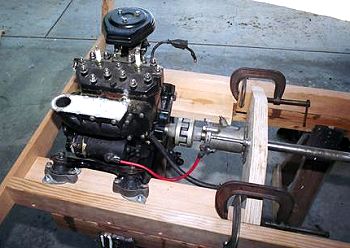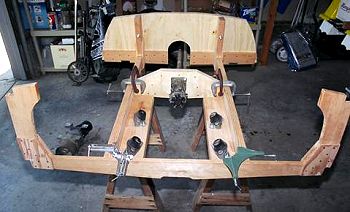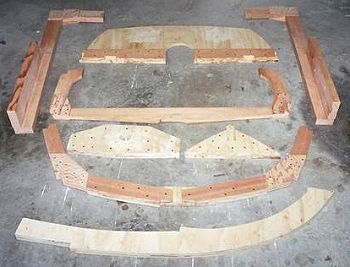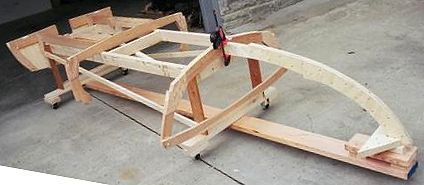Building the Squirt with a Kawasaki jet - Part 1
by Terry McIntyre
3-1-04:
I haven't done much woodworking in the last couple
of months, but a lot of design engineering! Turns out putting a jet drive in a
Squirt is a fairly complex proposition. In December, I cut out and assembled
the stem, breasthook, and both frames. The transom is cut out but not assembled
due to uncertainties in what needed to be done for the jet drive modifications.
I found and purchased a well-worn but good running jet ski (a 1982 550
Kawasaki) off e-Bay. Then I completely disassembled the jet ski to get all the
"good stuff" out, and measured all the critical dimensions. I also
purchased the  service manual for the
ski from Kawasaki. This gave me a wealth of good information - including things
like the jet pump thrust (340 lb) that I needed for the boat structural
modifications. Unfortunately, the manual didn't provide things like bolting
patterns, these I traced onto heavy paper, then transferred them to 1/4 plywood
to act as templates. The overall drive train length is 57 inches - too long to
put in the boat without lengthening it outside of the Glen-L recommended range.
For this reason I decided to mount the pump on a bracket outside the transom.
This allows me to lengthen the boat to 11'-4", and keep everything aft
of Frame #1. The primary structural modification is to eliminate both the keel
and inboard battens, aft of frame number 1. These are replaced with engine
stringers fabricated from 2x4 stock. Also, I added a half frame,
service manual for the
ski from Kawasaki. This gave me a wealth of good information - including things
like the jet pump thrust (340 lb) that I needed for the boat structural
modifications. Unfortunately, the manual didn't provide things like bolting
patterns, these I traced onto heavy paper, then transferred them to 1/4 plywood
to act as templates. The overall drive train length is 57 inches - too long to
put in the boat without lengthening it outside of the Glen-L recommended range.
For this reason I decided to mount the pump on a bracket outside the transom.
This allows me to lengthen the boat to 11'-4", and keep everything aft
of Frame #1. The primary structural modification is to eliminate both the keel
and inboard battens, aft of frame number 1. These are replaced with engine
stringers fabricated from 2x4 stock. Also, I added a half frame,  that I'm calling a
"bearing bulkhead" that supports the drive shaft, and forms the front
of the jet pump suction tunnel that runs down the center of the aft section of
the boat.
that I'm calling a
"bearing bulkhead" that supports the drive shaft, and forms the front
of the jet pump suction tunnel that runs down the center of the aft section of
the boat.
4-29-04:
I've now reached the point where I can actually
start boat building! As in indicated in my last update, I decided it would be a
good idea to "prototype" everything aft of Frame #1 with my motor
mount design arrangement, just to make sure everything worked. I bought some
inexpensive lumber, and built the motor stringers, engine mounts, and bearing
bulkhead. Then using the "real" frame #1 and transom, I clamped the
whole thing together to see if it worked. This turned out to be one of the best
things I ever did, as while my design was "close" it wasn't quite
"close enough". Based on the Kawasaki information that I have, the
tolerance on the engine location and alignment, relative to the drive shaft, is
a fraction of a millimeter. In order to accomplish this, I've  imposed a tolerance criteria of
1/32" on all the critical components in the engine drive train framework.
This will allow me to shim the engine to the required accuracy after the boat
is complete. I had to make a few changes to my original design, and then
fabricated up the "real" parts from clear select Douglas-fir. The
attached picture shows my version of the "Frame Kit". There are 3
"additional" parts that are required for my "inboard"
version of a Squirt - two motor stringer/motor mount/transom knee assemblies,
and the bearing bulkhead that will support the drive shaft. Once I had all the
parts finished, I did one final "dry fit" just to make sure it
worked. There are two photos, one showing just the drive shaft attached to the
bearing bulkhead, and a second with my engine mounted in the frame. Everything
fit perfectly!
imposed a tolerance criteria of
1/32" on all the critical components in the engine drive train framework.
This will allow me to shim the engine to the required accuracy after the boat
is complete. I had to make a few changes to my original design, and then
fabricated up the "real" parts from clear select Douglas-fir. The
attached picture shows my version of the "Frame Kit". There are 3
"additional" parts that are required for my "inboard"
version of a Squirt - two motor stringer/motor mount/transom knee assemblies,
and the bearing bulkhead that will support the drive shaft. Once I had all the
parts finished, I did one final "dry fit" just to make sure it
worked. There are two photos, one showing just the drive shaft attached to the
bearing bulkhead, and a second with my engine mounted in the frame. Everything
fit perfectly!  The last picture
shows the "frame kit" (temporarily) set up on the building form.
I'm not quite happy with the rigidity of the form yet, so I'm going to
add some additional bracing, and I still need to add the support framework for
the jet tunnel. This is needed to hold the location of the bearing bulkhead to
within the required 1/32" tolerance. Everything is taking about twice as
long as I thought it would, but I have to admit that the intellectual exercise
of designing the inboard engine supports has been a lot of fun.
The last picture
shows the "frame kit" (temporarily) set up on the building form.
I'm not quite happy with the rigidity of the form yet, so I'm going to
add some additional bracing, and I still need to add the support framework for
the jet tunnel. This is needed to hold the location of the bearing bulkhead to
within the required 1/32" tolerance. Everything is taking about twice as
long as I thought it would, but I have to admit that the intellectual exercise
of designing the inboard engine supports has been a lot of fun.
***
I would like to thank John Gage and Nate Brown, both of whom have completed jet squirts, and have answered every question I've sent them by e-mail.Next update will be when I get the frame complete and start to fair it up.
...Terry